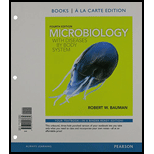
Concept explainers
To answer:
The nutritional classification of Desulforudis audaxviator. This bacterium lives underground, its energy source is sulfate, obtains electrons from hydrogen and builds the organic molecules by using the inorganic molecules seen in the nearby rocks.
Introduction:
All the bacteria require carbon source and energy source for their growth and development. Depending on the carbon and energy requirement, the bacteria can be classified into four categories, namely photoheterotrophs, photoautotrophs, chemoautotrophs, and chemoheterotrophs.
The microorganisms that utilize inorganic molecules as electron donors are known as lithotrophs. The microorganisms that use organic compounds as electron donors are known as organotrophs.
Want to see the full answer?
Check out a sample textbook solution
Chapter 6 Solutions
Microbiology with Diseases by Body System, Books a la Carte Edition & Modified Mastering Microbiology with Pearson eText -- ValuePack Access Card
- What are the three options to increase food production ? Discuss each giving the sailent features, merits and demerits .(please refer to XII NCERT)arrow_forwardExplain this The basic nutritional requirements of microorganisms are an energy or carbon source, an available nitrogen source, inorganic elements, and for some cell types, specific growth factors.arrow_forwardWhat are the results of the TSI from the enteric bacteria P. vulgaris? A. Black butt, yellow slant, glucose, lactose and/or sucrose fermented, H2S produced B. Black butt, red slant, glucose fermented, no gas C. Yellow butt, yellow slant, split agar, glucose, lactose and/ or sucrose fermented, gas produced D. Yellow butt, red slant, glucose only fermented, no gasarrow_forward
- Which of the following are characteristics of all coliforms? Select all that apply. -Aerotolerant anaerobes -Facultative anaerobes -Ferment mannitol and produce gas and acid -Ferment lactose and produce gas and acid -Found in the intestines of "warm-blooded" animalsarrow_forwardGiven the following raw main ingredients choose rhe possible food preservation method to be used and the product that can be madearrow_forwardWhat examples facilities in the US have Anaerobic digestion(AD)? Are these facilities mostly in rural areas?arrow_forward
- Why is the metabolism of Streptococcus bovis of specialconcern for ruminant nutrition?arrow_forwardBacteria that may cause food spoilage is known asarrow_forwardRemoval of the nitrogen-containing group from an amino acid is termed ____________. Question options: deamination azospirillification nitrogen fixation denitrification nitrificationarrow_forward
 Human Anatomy & Physiology (11th Edition)BiologyISBN:9780134580999Author:Elaine N. Marieb, Katja N. HoehnPublisher:PEARSON
Human Anatomy & Physiology (11th Edition)BiologyISBN:9780134580999Author:Elaine N. Marieb, Katja N. HoehnPublisher:PEARSON Biology 2eBiologyISBN:9781947172517Author:Matthew Douglas, Jung Choi, Mary Ann ClarkPublisher:OpenStax
Biology 2eBiologyISBN:9781947172517Author:Matthew Douglas, Jung Choi, Mary Ann ClarkPublisher:OpenStax Anatomy & PhysiologyBiologyISBN:9781259398629Author:McKinley, Michael P., O'loughlin, Valerie Dean, Bidle, Theresa StouterPublisher:Mcgraw Hill Education,
Anatomy & PhysiologyBiologyISBN:9781259398629Author:McKinley, Michael P., O'loughlin, Valerie Dean, Bidle, Theresa StouterPublisher:Mcgraw Hill Education, Molecular Biology of the Cell (Sixth Edition)BiologyISBN:9780815344322Author:Bruce Alberts, Alexander D. Johnson, Julian Lewis, David Morgan, Martin Raff, Keith Roberts, Peter WalterPublisher:W. W. Norton & Company
Molecular Biology of the Cell (Sixth Edition)BiologyISBN:9780815344322Author:Bruce Alberts, Alexander D. Johnson, Julian Lewis, David Morgan, Martin Raff, Keith Roberts, Peter WalterPublisher:W. W. Norton & Company Laboratory Manual For Human Anatomy & PhysiologyBiologyISBN:9781260159363Author:Martin, Terry R., Prentice-craver, CynthiaPublisher:McGraw-Hill Publishing Co.
Laboratory Manual For Human Anatomy & PhysiologyBiologyISBN:9781260159363Author:Martin, Terry R., Prentice-craver, CynthiaPublisher:McGraw-Hill Publishing Co. Inquiry Into Life (16th Edition)BiologyISBN:9781260231700Author:Sylvia S. Mader, Michael WindelspechtPublisher:McGraw Hill Education
Inquiry Into Life (16th Edition)BiologyISBN:9781260231700Author:Sylvia S. Mader, Michael WindelspechtPublisher:McGraw Hill Education





